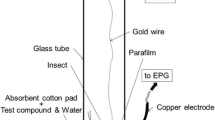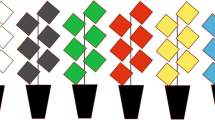Abstract
The testing behavior and test probing which are a part of host-plant acceptance behavior were studied in P. manihoti. Attention was focused on the testing behavior of three plants of the Manihot genus (Incoza, M'Pembé and Faux-caoutchouc) and a weed of the cassava fields (Talinum). This enabled us not only to characterize the associated behavior but also to show that the mealybug is able to distinguish between different host plants when walking on the leaf. The video description of the test probing of first- and fourth-instar larvae on M'Pembé and on the Faux-caoutchouc shows that the succession of the phases is similar. After a first phase characterized by the repeated intervention of the mealybug sensorial organs, a second phase, more mechanical, with up-and-down head movements, is observed. At this time, the stylets pass through the epidermic and inner tissues. Finally, a third phase, during which the mealybug becomes more agitated, is observed: it stands up using its rear legs and pushes the upper part of its body against the plant. The stylets continue their progression, which is principally intercellular, until they reach the phloem. Longer and longer immobility periods are observed over a period of time. We used the coupled videocamera and electrical penetration graph technique to see the relations existing between outer and inner plant events, i.e., between the behavioral items and the electrical signals characteristic of the stylets pathway in the plant. We observed that the stylet progression in the plant was more difficult in the resistant hybrid Faux-caoutchouc than in the sensitive M'Pembé variety.
Similar content being viewed by others
REFERENCES
Backus, E. A. (1988). Sensory systems and behaviors which mediate Hemipteran plant-feeding: A taxonomic overview. J. Insect Physiol. 34: 151–165.
Bernays, E. A., and Chapman, R.-F. (1994). Host-Plant Selection by Phytophagous Insects, Chapman & Hall, New York.
Blaney, W. M., and Duckett, A. M. (1975). The significance of palpation by the maxillary palps of Locusta migratoria (L.): An electrophysiological and behavioral study. J. Exp. Biol. 63: 701–712.
Caillaud, C. M., Pierre, J. S., Chaubet, B., and Di Pietro, J. P. (1995). Analysis of wheat resistance to the cereal aphid Sitobion avenae using electrical penetration graphs and flow charts combined with correspondence analysis. Entomol. Exp. Appl. 75: 9–18.
Calatayud, P. A. (1993). Relations nutritionnelles de la cochenille du manioc avec sa plante hôte, Thèse, INSA de Lyon, Lyon, p. 77.
Calatayud, P. A., Rahbe, Y., Tjallingii, W. F., Tertuliano, M., and Le Rü, B. (1994). Electrically recorded feeding behavior of cassava mealybug on host and non-host plants. Entomol. Exp. Appl. 72(3): 221–234.
Chapman, R. F. (1982). Chemoreception: The significance of receptor numbers. Adv. Insect Physiol. 16: 247–356.
Chapman, R. F., and Bernays, E. A. (1989). Insect behavior at the leaf surface and learning as aspects of host selection. Experienta 45: 215–222.
Dagnélie, P. (1975). Théorie et méthodes statistiques, Les Presses Agronomiques, Gembloux, Vol. II, pp. 54–58, 109–117, 242–245, 361–375.
Dreyer, D. L., and Campbell, C. C. (1987). Chemical basis of host plant resistance to aphids. Plant Cell Environ. 10: 353–361.
Eglinton, G., and Hamilton, R. J. (1967). Leaf epicuticular waxes. Science 156: 1322–1355.
Greenway, A. C., Griffiths, D. C., and Lloyd, S. L. (1978). Response of Myzus persicae to components of aphid extracts and to carbocylic acids. Entomol. Exp. Appl. 24: 369–374.
Hardie, J., Holyoak, M., Taylor, N. J., and Griffiths, D. C. (1992). The combination of electronic monitoring and video-assisted observations of plant penetration by aphids and behavioral effects of polygodial. Entomol. Exp. Appl. 62: 233–239.
Herren, H. R. (1987). Africa-wide biological control project of cassava mealybug and cassava green mite: A review of objectives and achievements. Ins. Sci. Appl. Spec. Issue 837–840.
Herren, H. R., and Neuenschwander, P. (1991). Biological control of cassava pests in Africa. Annu. Rev. Entomol. 36: 257–283.
Ibboston, A., and Kennedy, J. S. (1959). Interaction between walking and probing in Aphis fabae Scop. J. Exp. Biol. 36: 377–390.
Klingauf, F. (1969). Zur Wirtswahl der Grünen Erbsenlaus, Acyrthosiphon pisum (Harris) (Homoptera, Aphididae). Z. Angewandte Entomol. 65: 419–427.
Klinghauf, F. (1971). Die Wirkung des Glucosids Phlorizin auf das Wirtswahlverhalten von Rhopalosiphum insertum (Wald.) und Aphis pomi De Geer (Homoptera Aphididae). Z. Angewandte Entomol. 68: 41–55.
Klingauf, F. (1975). Die Frühphase in der Wirtswahl von Blattläusen. Med. Fac. Landbouww. Rijksuniv. Gent 40: 351–364.
Klingauf, F. (1987). Host plant finding and acceptance. Aphids. Their biology, natural enemies and control. In Minks, A. K., and Harrewijn, P. (eds.), World Crop Pests, Vol. 2A, Research Institute for Plant Protection, Wageningen, The Netherlands, pp. 209–220.
Le Rü, B., and Tertuliano, M. (1993). Tolerance of different host-plants to the cassava mealybug Phenacoccus manihoti Matile-Ferrero (Homoptera: Pseudococcidae). Int. J. Pest Manage. 39(4): 379–384.
Le Rü, B., Iziquel, Y., Biassangama, A., and Kiyindou, A. (1991). Variations d'abondance et facteurs de régulation de la cochenille du manioc Phenacoccus manihoti (Hom. Pseudococcidae) cinq ans après l'introduction d'Epidinocarsis lopezi (Hym., Encyrtidae) parasitoïde néotropical au Congo en 1982. Entomophaga 36(4): 499–511.
Le Rü, B., Renard, S., Allo, M. R., Le Lanic, J., and Rolland, J. P. (1995a). Antennal sensilla and their possible meaning in the host plant selection behavior of Phenacoccus manihoti Matile Ferrero. Int. J. Insect Morphol. Embryol. 24: 375–389.
Le Rü, B., Renard, S., Allo, M. R., Le Lanic, J., and Rolland, J. P. (1995b). Morphology and ultrastructure of sensory receptors of the labium of the cassava mealybug, Phenacoccus manihoti Matile Ferrero (Homoptera, Pseudococcidae). Entomol. Exp. Appl. 77: 31–36.
Montlor, C. B., and Tjallingii, W. F. (1989). Stylet penetration by two aphid species on susceptible and resistant lettuce. Entomol. Exp. Appl. 52: 103–111.
Neuenschwander, P., and Madojemu, E. (1986). Mortality of the cassava mealybug, Phenacoccus manihoti Mat. Ferr. (Hom., Pseudococcidae), associated with an attack by Epidinocarsis lopezi (Hym. Encyrtidae). Bull. Soc. Entomol. Suisse 59: 57–62.
Neuenschwander, P., Hammond, W. N. O., Ajuono, O., Gado, A., Echendu, N., Bokonon-Ganta, A. H., Allomasso, R., and Okon, I. (1990). Biological control of the cassava mealybug Phenacoccus manihoti Matile-Ferrero (Homoptera: Pseudococcidae) by Epidinocarsis lopezi (De Santis) (Hym.: Encyrtidae) in west Africa, as influence by climate and soil. Agr. Ecosyst. Environm. 32: 39–55.
Painter, R. H. (1951). Insect resistance in Crop Plants, University of Kansas Press, Lawrence.
Palm, R. (1993). Les méthodes d'analyse factorielle: principes et applications, Notes de Statistique et d'Informatique, Faculté des sciences agronomiques, Gembloux, pp. 15–32.
Pierre, J. S., and Kasper, C. (1990). La représentation des diagrammes de flux sur plans factoriels. Application de l'étude de la parade sexuelle du mâle de la courtillère (Grylloptera grylloptera, L.). Biol. Behav. 15: 125–151.
Silvestre, P. (1973). Aspects agronomiques de la production de manioc à la ferme d'état de Mantsoumba (Rép. Pop. Congo), Masson, Paris.
Smith, B. D. (1966). Effects of the plant alkaloid sparteine on the distribution of the aphid Acyrthosiphon sparteii (Koch). Nature 212: 213–214.
Sogawa, K. (1973). Feeding of the rice plant and leaf-hoppers. Annu. Rev. Plant Protect. Res. 6: 31–43.
Städler, E. (1986). Oviposition and feeding stimuli in leaf surface waxes. In Juniper, B., and Southwood, R. (eds.), Insects and the Plant Surface, Edward Arnold, London, pp. 105–121.
Storer, J. R., and van Emden, H. F. (1995). Antibiosis and antixenosis of chrysanthemum cultivars to the aphid Aphis gossypii. Entomol. Exp. Appl. 77: 307–314.
Tertuliano, M., Dossou-Gbete, S., and Le Rü, B. (1993). Antixenotic and antibiotic components of resistance to the cassava mealybug (Phenacoccus manihoti) (Hom. Pseudococcidae) in various host-plants. Insect Sci. Appl. 14: 657–666.
Tinbergen, N. (1953). L'étude de l'instinct (trans., Zélicourt, B., and Bourlière, F.), Payot, Paris.
Tjallingii, W. F. (1988). Electrical recording of stylets penetration activities. In Minks, A. K., and Harrewijn, P. (eds.), Aphids, Their Biology, Natural Enemies and Control, Elsevier, Amsterdam, pp. 95–108.
van Barren, J., Pierre, J. S., and Nénon, J. P. (1993). Analysis of oviposition behavior in the parasitoid Epidinocarsis lopezi (Hym.: Encyrtidae); Comparison of flow charts on factorial maps. Entomophaga 38(2): 207–218.
van der Heiden, P. G. M. (1978). Correspondence Analysis of Longitudinal Categorical Data, Dswo Press, Leiden.
van Emden, H. F. (1972). Aphids as phytochemists. In Harborne, J. B. (ed.), Phytochemical Ecology, Academic Press, London, New York, pp. 25–43.
van Helden, M., and Tjallingii, W. F. (1993). Tissue localisation of lettuce resistance to the aphid Nasonovia ribisnigri using electrical penetration graphs. Entomol. Exp. Appl. 68: 269–278.
Author information
Authors and Affiliations
Rights and permissions
About this article
Cite this article
Renard, S., Calatayud, PA., Pierre, JS. et al. Recognition Behavior of the Cassava Mealybug Phenacoccus manihoti Matile-Ferrero (Homoptera: Pseudococcidae) at the Leaf Surface of Different Host Plants. Journal of Insect Behavior 11, 429–450 (1998). https://doi.org/10.1023/A:1020911016042
Issue Date:
DOI: https://doi.org/10.1023/A:1020911016042




